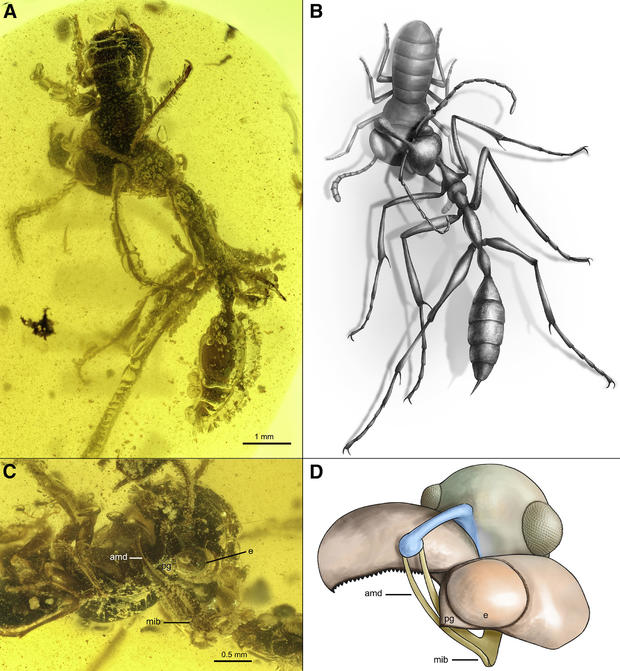Scientists discover amber tomb that shows a prehistoric "hell ant" killing its prey with bizarre jaws that look like the Grim Reaper's scythe
A 99-million-year-old amber fossil preserving a deadly encounter between two insects has proven what scientists long suspected about some of the Earth's first ants. The insect's ancestors had a deadly weapon in place of modern pincers — vertical jaws that looked like the Grim Reaper's scythe that were used to pin prey against a horn on their heads so that it was easier to keep ahold of their meal.
The discovery was published Thursday in the scientific journal "Current Biology."
The fossil was recovered in Myanmar and dates back to the final era when dinosaurs roamed the Earth, the Cretaceous Period. The piece of amber shows the exact moment a hell ant (haidomyrmecine) embraces its victim, a now-extinct relative of the cockroach (Caputoraptor elegans).
Phillip Barden, lead author of the study and an assistant professor at New Jersey Institute of Technology's Department of Biological Sciences, said in a press statement that fossilized behavior such as that of the hell ant's is "exceedingly rare."
"As paleontologists, we speculate about the function of ancient adaptations using available evidence, but to see an extinct predator caught in the act of capturing its prey is invaluable," Barden said. "This fossilized predation confirms our hypothesis for how hell ant mouthparts worked ... The only way for prey to be captured in such an arrangement is for the ant mouthparts to move up and downward in a direction unlike that of all living ants and nearly all insects."
The first hell ant was discovered roughly 100 years ago, Barden added, and since then, "it's been a mystery" why they are so different from more modern ant species.
"This fossil reveals the mechanism behind what we might call an 'evolutionary experiment,'" Barden said, "and although we see numerous such experiments in the fossil record, we often don't have a clear picture of the evolutionary pathway that led to them."
Barden tweeted news of the discovery on Thursday, saying these hell ants are "unlike any modern ants" and that the discovery was something they "never would have expected."
Today's ants have lateral moving mouth parts instead of vertical, scythe-like structures.
So far, scientists have identified 16 species of hell ants, and the latest discovery is not the most frightening to date.
Barden and others discovered another species of hell ant, Linguamyrmex vladi, otherwise called "Vlad the Impaler," in 2017, and found that this particular insect had a metal-reinforced horn on its head that was used to impale prey so that it could feed on its hemolymph, or internal liquid.
Now, the scientists are using this latest discovery to find out what biological traits may allow modern ants to flourish in the future, and to remind people that even the smallest creatures face extinction. It is still unclear what drove haidomyrmecines to become extinct after roaming Asia, Europe and North America for 20 million years, Barden's study explains.
"Over 99% of all species that have ever lived have gone extinct," Barden said. "As our planet undergoes its sixth mass extinction event, it's important that we work to understand extinct diversity and what might allow certain lineages to persist while others drop out."





